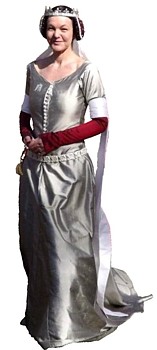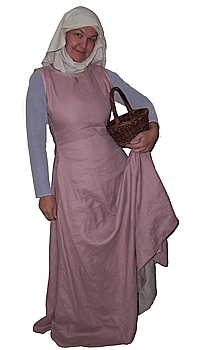Acquiring
Women's Clothes
NOBLEWOMEN'S CLOTHES - RICH MERCHANT CLASS WOMEN'S
CLOTHES - WORKING CLASS WOMEN'S CLOTHES -
PEASANT WOMEN'S CLOTHES - SECOND-HAND CLOTHES IN WILLS - SECOND
HAND CLOTHES MERCHANTS
Noblewomen's
clothes
 A
noblewoman would not make her own clothing, although she would
have a good knowledge of how clothes were made and what was fashionable.
Her clothing would be made by a tailor who was hired specifically
to make custom-fitted garments for the social elite. If a noble
family was wealthy enough and had an extensive staff, they might
hire a tailor exclusively. A
noblewoman would not make her own clothing, although she would
have a good knowledge of how clothes were made and what was fashionable.
Her clothing would be made by a tailor who was hired specifically
to make custom-fitted garments for the social elite. If a noble
family was wealthy enough and had an extensive staff, they might
hire a tailor exclusively.
Her fabrics would be of the finest wools, silks, silk velvets
and brocades. Linens would have been fine.
In the case of Royal households, a tailor might be employed full-time
along with other laundresses and clothing specialists. Not only
did it ensure that the tailor was always available to that family,
it prevented other families from hiring him or her. A tailor who
worked in a shop in town was available to anyone with the money
to pay for his services.

Rich
merchant class women's clothes
Rich townswomen may have engaged in their husband's trade, worked
the shop front while he worked producing goods or have been solely
in charge of her own household and staff. Her work was neither
hard nor grubby. Her fabrics would include fine linens and wools
of a high quality. Brocades of some quality would be worn, but
not those that equalled the nobility.
Her clothing was also made by hand, whether by herself or bought
off the rack from a mercer's store. Ready-made clothing was available
to the rich townswoman, but many women may have still preferred
to make their own in order to get a better fit. By sewing her
clothing herself, the townswoman was able to have a good-fitting
garment without the expense of hiring a professional tailor to
make it. Many, of course, did get their clothes tailor-made. Most
of these women were very well off and strove to emulate their
noblewomen icons in dress.
Although second hand clothes were available to the wealthy
townswomen, the thought of being caught in another woman's hand-me-down
would most likely have seemed appalling.

 Working
class women's clothes Working
class women's clothes
Women who worked often carried out their husband's trade and therefore
wore specialised clothes specific to their employment. Other women
who worked also had clothing suitable to work in rather than regular
clothes with which they might tend the front of a shop.
Working class
clothes were also made by hand, whether by herself or bought off
the rack from a mercer's store. The fabric available was more
varied and of a better quality than that of peasant women, but
usually it was of a sturdy nature in order to stand up to the
rigors of labour and be durable.
Ready-made clothing was available, but many women may have still
preferred to make their own or buy second-hand from a fripperer's
shop. Working class women had less money to spend on clothing
but still valued good cloth, and were the class most likely to
have purchsed second hand clothes.
A clever lady could remodel or cut down one style of gown into
another using the good fabric which she may not have been able
to afford normally.
Sumptuary laws
dictated whether these garments could be lined with furs and what
kind of furs were permitted to the lower classes, but in all liklihood,
valuable furs were probably stripped from garments before on-selling.
County fairs once a year may have provided extra opportunities
for clothing acquisition.

Peasant
or rural women's clothes
Peasant women usually made their own clothing at home. This in
now way implies that the quality of their clothing was poor or
shoddy. A woman who did all her weaving and sewing by hand would
be able to produce a high standard of workmanship. The main difference
between the clothing worn by a peasant woman and a townwoman would
be the quality of the fabric itself and the colours available.
A peasant woman would need to make sure her clothing was strong
and durable and since she made it herself- it was all custom made
to fit. It needed to be roomy enough to work in around the shoulders
but this does not mean her clothes hung like a sack or were not
well made.
Sumptuary laws in medieval
Europe are discussed in SBS's Europe In The Middle Ages
saying:
By law, what a peasant
wears must be either black or grey- nothing else is permitted-
a coarse linen smock is appropriate, wooden clogs and one
pair of leather boots. That is enough.
I don't understand how peasants
were expected to wear black when the dying process to produce
black dye would not be affordable to peasants.
For the very poor or at special times of the year, clothing might
be given to the poor by the wealthy as part of celebrations or
as gifts by the church or wealthy patrons who made gifts of clothing
to the poor. A peasant woman who worked for a well-off family
in town could expect to recieve a new gown as part of her yearly
upkeep. Not only was this a form of charity from the part of the
employer, in also ensured that the staff they employed were reasonably
dresses and fit to be seen as part of their retinue.

Secondhand
clothes in wills
Second hand clothing were usually of two kinds. Firstly, clothing
that was bought from a second-hand clothing merchant called a
fripperer and clothing that was handed down. Often clothing
was included in wills and specific beneficiaries were names as
to who received what.
Servants often had clothing
handed down to them, particularly gowns which might be of value
or in good repair. One London merchant's will records a bequeath
of
...12d and one of my
old gowns to make her a kirtell.
hinting that the old gown
which was being passed on would be cut up and remodeled to make
a new garment for a new wearer. Since fabric was an expensive
commodity, this does not come a real surprise.
One example from a private
will dated 17 June, 1550 of a man described as a Citizen and Fruiterer
of London, England states:
To my sister Magher,
the best gown that was my well-beloved wife’s Alice’s,
her best kirtle
His own clothing gifts were
extremely extensive including fabrics which included velvet, satin
and taffeta. The wife's gown does not specify what the kirtle
is made from, so it is to be assumed that it is none of these
fabrics or they would have been especially mentioned. This shows
that a prosperous merchant could own garments of good enough quality
and value that they need to be specified as to who might receive
them and not just left for general distribution among family and
friends. They were specifically intended to specific persons because
of their value.
The will of Joan Buckland, widow, of Edcock who dies in 1462 leaves:
...all my other gowns
and kirtles, that they be given to my women servants dweling
with me and my departure. Also to the woman that is by me at
the time of my departing... one gown furred with mink.
Clothing was often handed
down from a mistress to her ladies-in-waiting. A noblewomen was
expected to keep up to date with current fashions and although
she might keep an outer garment for a few years the same way we
keep a favourite winter jacket, she might look to replace her
undergowns which were usualy visible. Undergowns would be handed
down, if the fabric was suitable, and re-made or re-fitted to
suit the new wearer's status. Trains might be trimmed and fur
removed to make an outfit suitable for a lady-in-waiting.
A 1459 bequest from York from widow Joan Cotyngham, shows that
even underwear might be gifted:
I also leave to Joan
Day, a poor little woman staying in a certain maison-dieu, my
russet gown lined with buckshin and a chemise of linen cloth.

Second
hand clothes merchants
Francoise Piponnier and Perrine Mane in their book, Dress in
the Middle Ages, say that clothing might be bought from sales
held in the market square. Buyers might be private persons or
secondhand merchants who would re-sell at an increased price.
These merchants bought and
sold in used clothing much the same as our second-hand clothes
shops today with the exception that clothing was by far a more
valuable commodity than today and far less disposible. Secondhand
clothing dealers were closely monitored and could either have
a shop in the town or wander the streets offering their wares.
A person who bought second hand clothes might have it recut to
fit the new owner, or have the garment unpicked and remade inside
out so that the fabric which was not exposed to the ouside elements
became the inside and the fresh side of the fabric became the
outer. This process gave a fresh, new look to otherwise faded
material.
Hand-me-down clothing was often handed down for the same reason
as families do today. Should a growing child outgrow an item of
clothing, it would hardly be thrown out; it would be passed down
to the next smallest child in the house, especially in households
of lower financial standing.

Copyright
© Rosalie Gilbert
All text & photographs within this site are the property of
Rosalie Gilbert unless stated.
Art & artifact images remain the property of the owner.
Images and text may not be copied and used without permission.
|